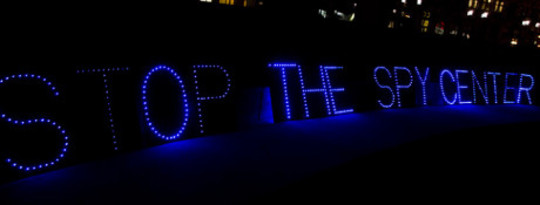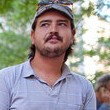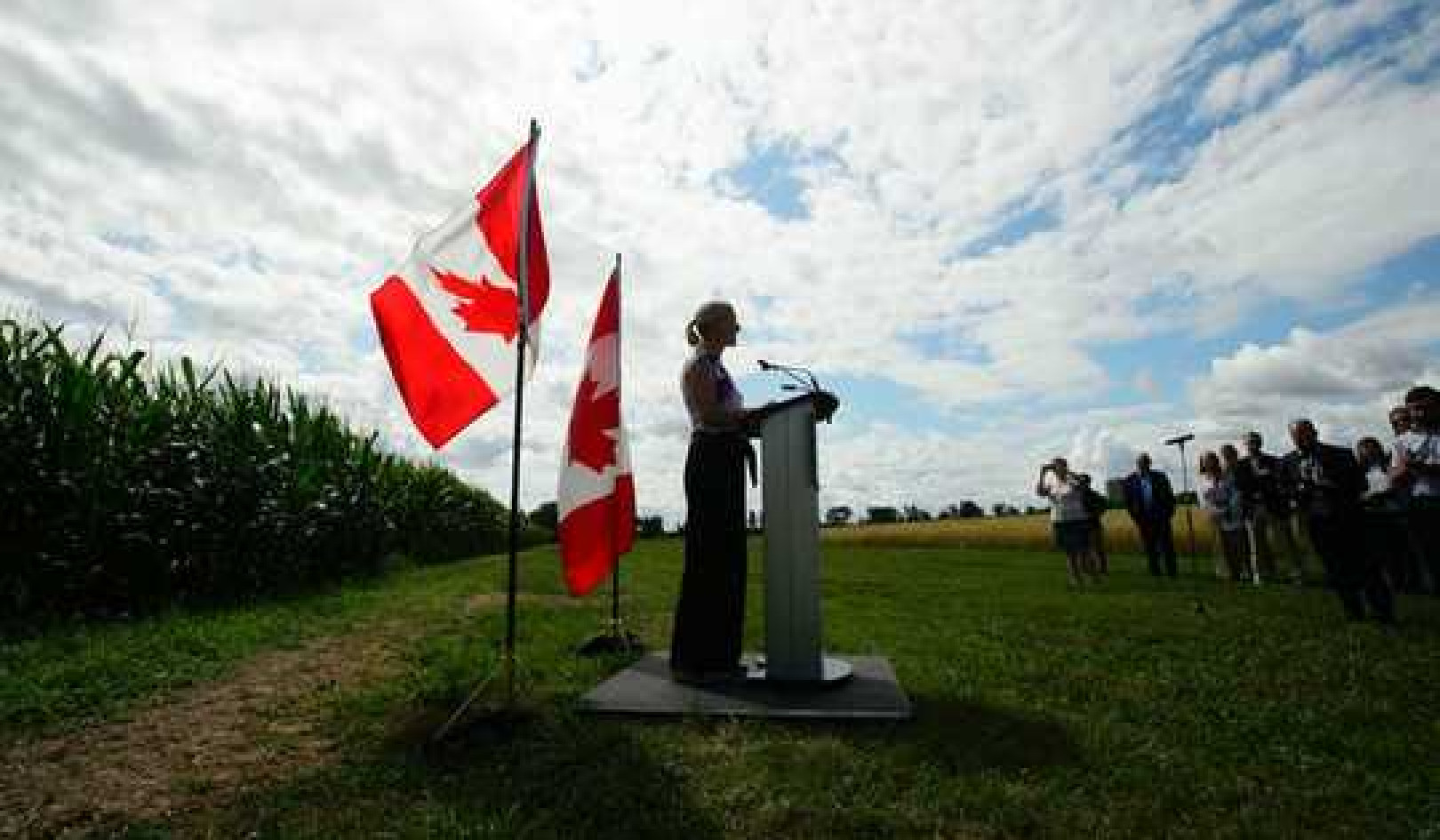 On Feb. 2, 2014, Oakland activists gathered to protest the construction of a proposed mass surveillance center. (Flickr/Daniel Arauz)
On Feb. 2, 2014, Oakland activists gathered to protest the construction of a proposed mass surveillance center. (Flickr/Daniel Arauz)
“With liber—ty and just—ice for all,” said the girl at the microphone. She accentuated the ends of her words, almost as if she were performing slam poetry, so the members of the city council had more time to contemplate their meaning and gravity. After a short pause, she recalled how she had recited the Pledge of Allegiance every morning in school during her childhood.
“I never thought all that time I would be practicing to remind you all here, tonight,” she mused.
Her testimony fell somewhere in the middle of the public comments portion of the Oakland City Council meeting earlier this month. It was far from a routine meeting. Later that night, the council was to vote on the plan to build a domain awareness center, a massive surveillance hub that would aggregate the public and private feeds from cameras and sensors from across the city, as well as data and updates from social media.
That night, some 149 people had signed up to speak. Throughout the eight-hour meeting, the air was electric and expectant as more than one hundred people voiced their unanimous resolve to keep mass surveillance out of Oakland.
A Nine-Month Fight
The most recent chapter of the fight began on July 30, 2013, when the Oakland City Council unanimously approved a $2 million grant from the Department of Homeland Security to begin the second phase of construction for a domain awareness center in Oakland. The vote occurred despite outspoken community opposition, the dissenting testimonies of nearly 50 speakers and the urging of organizations like the ACLU. The plan called for the domain awareness center to integrate cameras and data from across the city into one mass surveillance system. According to the domain awareness center wiki, a clearinghouse of information kept by activists, the plan also called for the implementation of new technologies such as license-plate-reading devices, biometrics, thermal imaging and possibly facial-recognition technology. Prior to vehement protests, the plan also called for the purchase of drones and a network of cameras for the Oakland city public schools.
After the council approved the domain center’s construction, Oakland activists launched a militant research strategy and a public relations blitz that quickly yielded results. By mid-October, the plan had made national headlines, including a New York Times article that sharply criticized the proposed center. In November, an even bigger story broke. Public records requests filed by activists yielded more than 4,000 pages of communications, some of which showed that the contractor responsible for the center’s construction, Science Applications International Corporation, was in violation of a city law stipulating that Oakland can’t do business with firms that also work with nuclear weapons. These documents also revealed that the city appears to have knowingly concealed this information.
On Jan. 27, 2014, the Oakland privacy working group, a group of privacy activists loosely associated with Occupy Oakland,issued a cease and desist order to the city to halt Science Applications International Corporation’s construction of the center. The next day, the city of Oakland’spublic safety committee expedited its recommendation that another contractor, Schneider Electric, appear before the city council.
Two major protests in early February kept the issue at the forefront of the public’s attention. At a Feb. 18 council meeting, nearly 80 community members signed up to speak out against the center. It was the first time since this nine-month fight began that council members showed serious misgivings about moving forward. Some council members indicated that they would be only willing to support a scaled-back version of the plan that would be limited to monitoring the city’s port. Council members also expressed confusion over how the proposed domain awareness center had evolved from being limited to the port to offering blanket mass surveillance of the entire city. After five hours of debate, the vote was postponed until the following meeting on March 4.
A Ballooning Issue
On the night of the March 4 vote, community members and organizations from all different backgrounds flooded into the city hall. The ACLU and other pro-privacy organizations were joined by Muslim and Asian American community groups, whose past and recent experience of being targeted for surveillance drove them to oppose this new, integrated form. The Oakland privacy working group issued a letter to council members with the signatures of over 35 organizations.
“The longer this fight goes on, the more broad this coalition gets,” said Brian Hofer of Oakland Privacy Working Group.
“Trust has been broken with the Muslim community,” said Imam Zaid Shakir of the Lighthouse Mosque at a press conference prior the city council meeting. But, he continued, the center was “not a Muslim issue, but an American issue.”
Just before the meeting, Mayor Jean Quan quickly issued an open letter of support for restricting the domain awareness center to the port only, which would limit the scope of the surveillance and data collection to the area around the port and the airport, and would call for surveillance cameras already installed as part of the original plan to be decommissioned.
“As we’ve gone through our public process over the last several weeks, many of our residents and other Oakland stakeholders have let us know they have serious concerns about how the center could affect their rights to privacy,” Quan said. “Let’s be very clear: preserving public safety also means safeguarding those rights.”
Since Sept. 11, 2001, the surveillance industry has been growing exponentially. According to TomDispatchwriters Mattea Kramer and Chris Hellman, the United States has spent an estimated $791 billion on homeland security since the attacks, which — when adjusted for inflation — is more than 1.5 times the amount spent on the New Deal.
However, within the last year, the resistance to this surveillance system has grown as well. In August 2013, now famous whistleblower Edward Snowden leaked documents that revealed U.S. security agencies were spending $52.6 billion each year on intelligence gathering that included the controversial telephone metadata gathering and storing programs. Even pro-surveillance lawmakers have recently expressed concern over the ever expanding spying industry. Earlier this month Sen. Dianne Feinstein of California accused the CIA of spying on the Senate Intelligence Committee, the very body responsible for overseeing the activities of U.S. surveillance agencies.
Against this backdrop, municipal struggles over mass surveillance take on increased significance. As it becomes more and more clear that these agencies are wastefully overfunded, as a bipartisan 2012 report on fusion centers found, communities must decide whether to stand up for their civil liberties when elected officials are no longer able to advocate for them.
This is precisely what is happening in Oakland.
The Vote
On March 4, former city council member Wilson Riles, Jr. was the first public speaker to chime in on the proposed domain awareness center. A longtime activist, Riles recalled when the city of Oakland purchased a helicopter for the Oakland Police Department during his city council tenure. He and other council members were taken up in the air during a demonstration. But instead of carrying out police work, he remembered the pilots of the aircraft shining their spotlights on women walking down the street and laughing.
Riles was the first of a slew of people to advocate against the center’s construction. Linda Lye of the ACLU of Northern California pointed out that there was an ominous provision that referred to the monitoring of “news feeds and alerts.” Jordan Hoffman, a security professional, argued that the center would get hacked. Michael Thomas, a lawyer with the National Lawyers Guild, argued, “Data aggregated on communities of color will be used to justify force.” One masked activist simply read a passage from Michel Foucault’s Discipline and Punish.
After more than 100 speakers, the city council and Mayor Quan voted to restrict the domain awareness center to monitoring the port and the airport only. Depending on whom you ask, the decision was either a major victory or a colossal failure.
Brian Hofer said that while he was pleased to see the center limited, he was disappointed that it wasn’t defeated outright. The ACLU was more optimistic. “Last night’s vote by the Oakland City Council to significantly curtail the scope of the domain awareness center is a real win for privacy and civil liberties and for participatory democracy,” said Linda Lye, staff attorney with the ACLU of Northern California. She credited the city council for responding — at least partially — to the public’s concerns.
Lessons Learned
Keeping the center confined to the port sets an important precedent for privacy advocates everywhere, even if it wasn’t the shutout victory many wanted. There was no single strategy that was responsible for forcing the city council to compromise. Rather, it was a combination of legal organizing, research, outreach, coalition building and street protests. Community organizing also played an important role by bringing speakers from key sectors of society out for the vote. This organizing followed a decentralized model in which organizers already in communities helped bring out their constituencies, which helped ensure that people were not tokenized. This model also did not require activists who had spearheaded other aspects of the campaign, such as the legal and research advocacy, to attempt the difficult — and often unsuccessful — work of organizing an unfamiliar community from the ground up.
As other cities begin gearing up for similar fights, like the one now underway in Seattle, activists in Oakland have vowed to keep pushing to rid the city of any domain awareness center. Key organizers have said that they will begin organizing to vote pro-center council members out of office in order to block the now approved port-only center. This militant stance — one that demands no surveillance and accepts no compromises — may be a source of disappointment for activists in the East Bay now. But it is precisely this attitude that propelled them from defeat only nine months ago to a victory that may well extend even further.
This article originally appeared on WagingNonviolence
About the Author
 Tom Hintze is an activist, writer and photographer from New York. He started working in the Occupy Wall Street Kitchen in Liberty Square in October, organizing horizontally with a small group of people to coordinate meals for between one and five thousand people daily. He has also been a part of the Direct Action Working Group at OWS, and has helped plan dozens of actions. He has written and edited for Tidal and Occupy Theory.
Tom Hintze is an activist, writer and photographer from New York. He started working in the Occupy Wall Street Kitchen in Liberty Square in October, organizing horizontally with a small group of people to coordinate meals for between one and five thousand people daily. He has also been a part of the Direct Action Working Group at OWS, and has helped plan dozens of actions. He has written and edited for Tidal and Occupy Theory.
Recommended book:
This Changes Everything: Occupy Wall Street and the 99% Movement
by Sarah van Gelder and staff of YES! Magazine.
 This Changes Everything shows how the Occupy movement is shifting the way people view themselves and the world, the kind of society they believe is possible, and their own involvement in creating a society that works for the 99% rather than just the 1%. Attempts to pigeonhole this decentralized, fast-evolving movement have led to confusion and misperception. In this volume, the editors of YES! Magazine bring together voices from inside and outside the protests to convey the issues, possibilities, and personalities associated with the Occupy Wall Street movement. This book features contributions from Naomi Klein, David Korten, Rebecca Solnit, Ralph Nader, and others, as well as Occupy activists who were there from the beginning.
This Changes Everything shows how the Occupy movement is shifting the way people view themselves and the world, the kind of society they believe is possible, and their own involvement in creating a society that works for the 99% rather than just the 1%. Attempts to pigeonhole this decentralized, fast-evolving movement have led to confusion and misperception. In this volume, the editors of YES! Magazine bring together voices from inside and outside the protests to convey the issues, possibilities, and personalities associated with the Occupy Wall Street movement. This book features contributions from Naomi Klein, David Korten, Rebecca Solnit, Ralph Nader, and others, as well as Occupy activists who were there from the beginning.
Click here for more info and/or to order this book on Amazon.
























